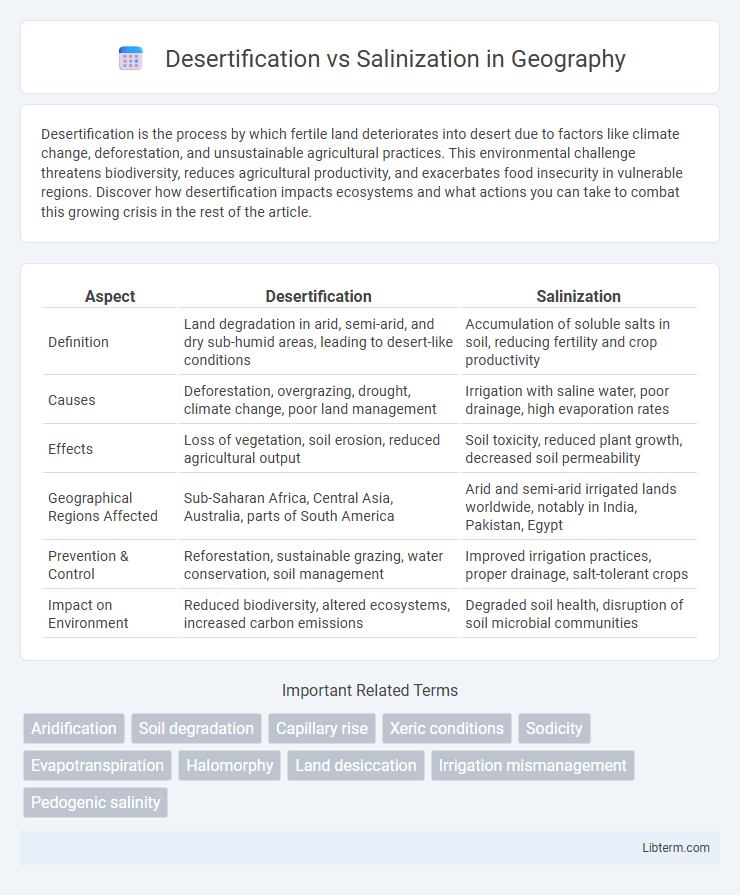Desertification is the process by which fertile land deteriorates into desert due to factors like climate change, deforestation, and unsustainable agricultural practices. This environmental challenge threatens biodiversity, reduces agricultural productivity, and exacerbates food insecurity in vulnerable regions. Discover how desertification impacts ecosystems and what actions you can take to combat this growing crisis in the rest of the article.
Table of Comparison
| Aspect | Desertification | Salinization |
|---|---|---|
| Definition | Land degradation in arid, semi-arid, and dry sub-humid areas, leading to desert-like conditions | Accumulation of soluble salts in soil, reducing fertility and crop productivity |
| Causes | Deforestation, overgrazing, drought, climate change, poor land management | Irrigation with saline water, poor drainage, high evaporation rates |
| Effects | Loss of vegetation, soil erosion, reduced agricultural output | Soil toxicity, reduced plant growth, decreased soil permeability |
| Geographical Regions Affected | Sub-Saharan Africa, Central Asia, Australia, parts of South America | Arid and semi-arid irrigated lands worldwide, notably in India, Pakistan, Egypt |
| Prevention & Control | Reforestation, sustainable grazing, water conservation, soil management | Improved irrigation practices, proper drainage, salt-tolerant crops |
| Impact on Environment | Reduced biodiversity, altered ecosystems, increased carbon emissions | Degraded soil health, disruption of soil microbial communities |
Understanding Desertification: Definition and Causes
Desertification is the degradation of land in arid, semi-arid, and dry sub-humid areas, primarily caused by factors such as deforestation, overgrazing, agricultural activities, and climate change-induced droughts. It results in the loss of soil fertility, reduced vegetation cover, and diminished water availability, severely impacting ecosystems and human livelihoods. This process differs from salinization, which specifically involves the accumulation of soluble salts in soil, often due to improper irrigation practices.
What is Salinization? Key Concepts Explained
Salinization is the accumulation of soluble salts in soil or water, leading to reduced agricultural productivity and soil degradation. Key concepts include the sources of salinity such as irrigation with saline water, poor drainage, and natural mineral weathering. Unlike desertification, which involves land degradation primarily due to vegetation loss and erosion, salinization specifically affects soil chemistry by increasing salt concentration, impairing plant growth and crop yields.
Desertification vs Salinization: Core Differences
Desertification involves the degradation of land in arid, semi-arid, and dry sub-humid areas due to factors like drought, deforestation, and inappropriate agriculture, resulting in loss of soil fertility and vegetation cover. Salinization specifically refers to the accumulation of soluble salts in soil, often caused by improper irrigation practices or poor drainage, which reduces crop productivity and soil health. While desertification represents a broader environmental process affecting entire ecosystems, salinization is a distinct soil degradation issue primarily linked to salt buildup.
Worldwide Hotspots: Regions Most Affected
Desertification and salinization severely impact worldwide hotspots such as the Sahel region in Africa, Central Asia, and parts of Australia, where arid and semi-arid climates dominate. These regions face accelerated loss of fertile land due to prolonged drought, deforestation, and unsustainable agricultural practices, intensifying soil degradation. Salinization hotspots often include irrigated agricultural lands in the Indus Valley, the Murray-Darling Basin in Australia, and the Aral Sea basin, where excessive irrigation and poor drainage elevate salt levels, reducing crop productivity.
Impact on Agriculture: Yield and Food Security
Desertification reduces arable land by degrading soil structure and moisture retention, leading to significant declines in crop yields and increased food insecurity. Salinization causes toxic salt accumulation in soil, impairing plant growth and reducing agricultural productivity, particularly in irrigated lands. Both processes threaten global food security by limiting the availability of fertile land and decreasing the resilience of agricultural systems.
Environmental Consequences of Land Degradation
Desertification leads to the loss of fertile land, reducing biodiversity and disrupting ecosystems by turning productive areas into arid, barren landscapes. Salinization causes soil toxicity, impairing plant growth and decreasing agricultural yields, which contributes to food insecurity and habitat degradation. Both processes exacerbate water scarcity, increase greenhouse gas emissions, and threaten the sustainability of rural livelihoods and natural resources.
Human Activities Driving Desertification and Salinization
Human activities such as deforestation, overgrazing, and unsustainable agricultural practices significantly accelerate desertification by depleting soil nutrients and disrupting vegetation cover. Irrigation practices that lead to poor drainage cause salinization, as accumulated salts in the soil inhibit plant growth and reduce land productivity. Both processes result in severe land degradation, threatening food security and livelihoods in arid and semi-arid regions worldwide.
Preventive Strategies and Sustainable Solutions
Preventive strategies for desertification include reforestation, sustainable land management, and controlled grazing to maintain soil structure and moisture. Salinization prevention relies on efficient irrigation techniques such as drip irrigation, proper drainage systems, and crop selection tolerant to salt accumulation. Sustainable solutions involve integrating agroforestry, enhancing organic matter in soil, and employing policies that promote water conservation and land rehabilitation to ensure long-term soil health and productivity.
Global Economic Burden: Comparing Costs
Desertification causes an estimated global economic loss of over $42 billion annually due to reduced agricultural productivity and land degradation, particularly impacting regions in Africa, Asia, and Latin America. Salinization affects approximately 20% of irrigated lands worldwide, leading to crop yield losses valued at around $12 billion every year, primarily in arid and semi-arid regions. Both processes exacerbate food insecurity and increase remediation costs, placing substantial strain on national economies and global food supply chains.
Future Outlook: Addressing Land Degradation Challenges
Future outlook on desertification and salinization emphasizes sustainable land management practices, including reforestation, improved irrigation techniques, and soil conservation measures. Technological advancements in remote sensing and AI-driven monitoring enable early detection and mitigation of land degradation hotspots. International cooperation and policy frameworks promoting climate resilience and land restoration are critical to reversing current trends and ensuring food security.
Desertification Infographic

 libterm.com
libterm.com